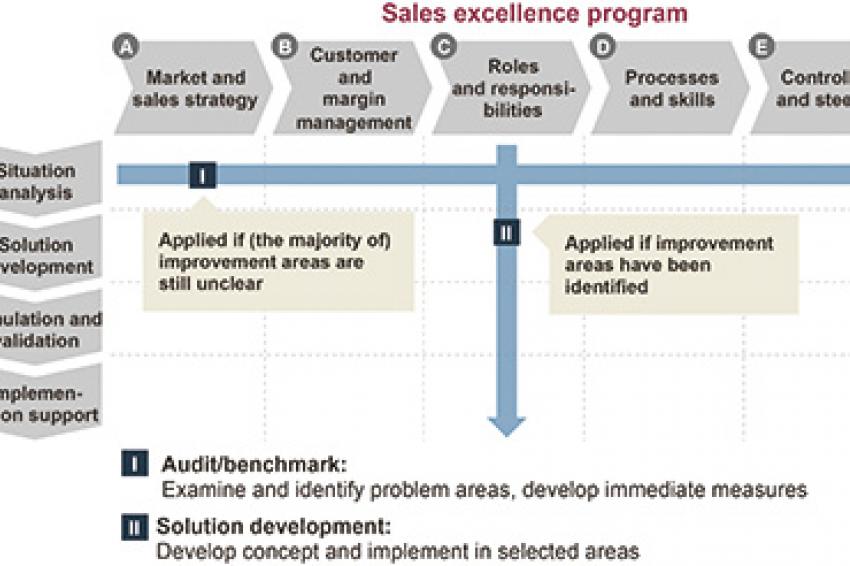Sales in the Chemical Industry
A study themed "Sales excellence - Boost your sales power" reveals interesting facts
A study themed "Sales excellence - Boost your sales power" conducted by Simon-Kucher & Partners together with CHEManager International reveals that chemical companies focus their sales activities primarily on the goals of either boosting profits or acquiring new customers. The approaches used to accomplish these goals vary widely among the chemical firms. Still, they have one thing in common: They both see the need for action and improvement.
According to the managers responding to the survey, most companies have clear targets in sales and orientate their priorities and sales activities on them. They often run into trouble, though, when it comes to the individual steps of the operationalization. Most of the respondents say they know which levers need to be worked on, but they don't know how to go about it. Furthermore, those who do manage to implement improvements often fail to coordinate the diverse areas and end up with an ill-orchestrated sales process.
Effectiveness over Efficiency: Optimize Margins, Gain New Customers
Not surprisingly, top-line targets such as improving margins and gaining new customers are high on the list of sales objectives. While sales costs don't play a major role, almost all of the respondents admit that they want to deal with at least one of these topics.
The companies differentiate widely depending on firm size. More than three-fourths of the small companies (less than €50 million revenue) list customer acquisition as the most important sales target. In contrast, a similar number of large companies (more than €250 million revenue) say that improving their margins is the No. 1 priority. This discrepancy is likely due to the fact that smaller firms want to increase their business through new customers. Large companies, however, are already nearing their growth limits and prefer to focus on tapping the profit potential of their current customer base.
Margin Focus: Approach Attractive Segments and Customers Even Better
Companies that concentrate on margin optimization reflect this in how they assess their sales process activities. They feel it is crucial to clearly define and prioritize target segments and customers - an important prerequisite for identifying margin improvement potential. What's more, they strive to create a differentiated sales strategy with which they can efficiently target the most attractive segments. Companies that want to boost margins also focus on optimizing their internal processes. Sales roles and responsibilities need to be clearly distributed; areas of expertise must be defined. To achieve sustainable process improvements, a win-loss order analysis is absolutely crucial.
And so, margin-oriented firms see the biggest need for action in areas with the most powerful levers for boosting profits. Aside from the areas of market and sales strategies mentioned earlier, they also see customer value assessments as a decisive means of dealing with customers and thereby tapping their margin potential.
Gain New Customers: Improve Sales Campaigns and Processes
Firms that focus on acquiring new customers see sales campaigns and knowledge of decision-maker structures among customers as considerably more important. The latter is essential for a targeted approach to new customer acquisitions. Moreover, it's paramount for these companies that their working time is spent effectively and logically on core sales activities. Sales teams must have enough time for customer contact; internal resources should thereby be organized to facilitate this. Systematically preparing for and following up on customer visits is a vital component related to transparent processes. All of these factors help to optimize and professionalize the sales process. In these topics, along with customer development, firms focused on customer acquisitions see the biggest need for action. Smaller companies, that have the primary goal of gaining new customers, are often dependent on single sellers and still need to establish and professionalize their sales structures.
Sales is a Process and Must be Treated as Such
The various components of the sales process are closely related to one another and should not be viewed in an isolated way. In practice, this is not always the case, though, and often single aspects fail in operations, as is evident in several examples. About one-half of the surveyed firms stated that they have defined and documented sales targets for target segments. Yet only one out of five of these firms use those targets to steer their sales team.
Another example can be found by looking at processes in terms of price negotiations and negotiation skills. For margin-focused companies, this is very important. Approximately half of the companies say that they have the expertise and an escalation scheme set up for price negotiations. At the same time, only one-third of these companies conduct sales and negotiation training seminars in their companies. This is a powerful example of how rules are set up internally, but the necessary operative support to implement them is missing.
Sales must be seen as a process - one in which various activities are often closely related and must be carefully coordinated to achieve the best possible results.
First Step Toward Strong Sales Teams
What should they do? As long as margins are the focus, companies should first prioritize markets and manage them according to their profitability and potential. This is decisive to identify corporate sweet spots and to effectively deploy internal resources. To secure margins, it's just as important to install efficient steering systems: The right KPIs (e.g., win-loss analysis) are as crucial as the right remuneration system.
For companies focused on gaining new customers, a clear and precise definition of growth segments is a step in the right direction. Sales structures and roles must facilitate a focus on customer acquisitions. These companies have to ensure that the sales team is 100% committed to acquiring new customers and not tied up with administrative tasks. Creating lists of targeted customers and requiring preparation and follow-up on customer visits ultimately encourage sales teams to share their experience and learn from one another.
Whether the focus is on boosting margins or gaining new customers, both company types must be clear about which pressure points need to be worked on. If it's unclear which areas need to be improved, an audit or a benchmark analysis of the sales process - available here - can help to identify and approach the areas, as Figure 3 shows. Only then can the companies achieve a sustainable boost in sales.












